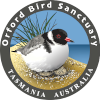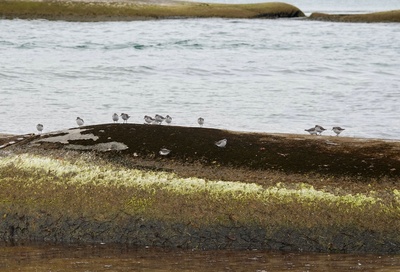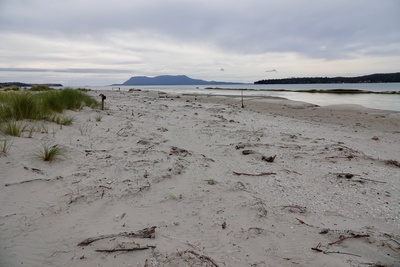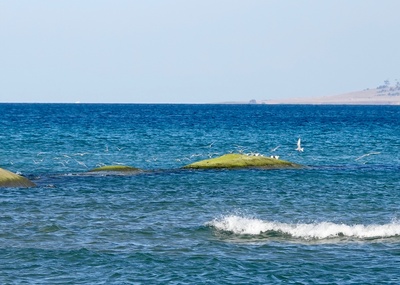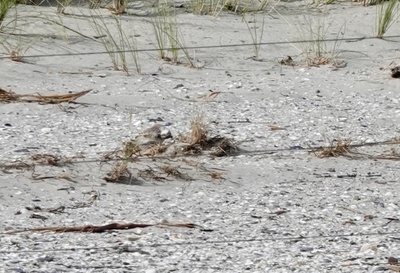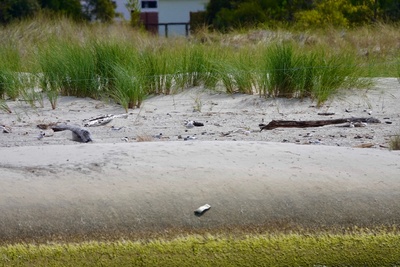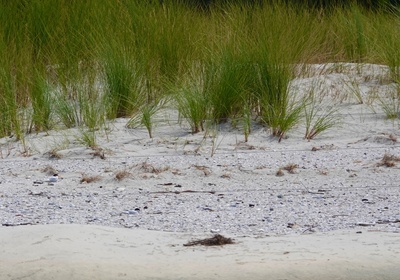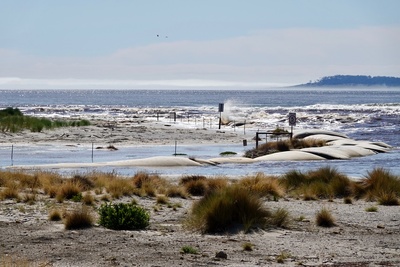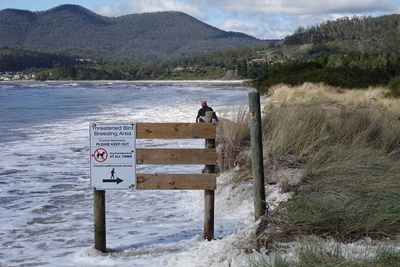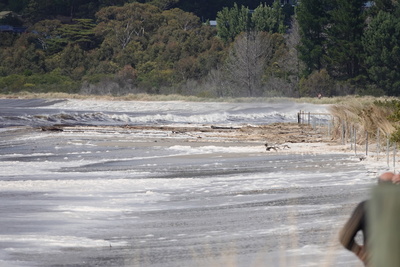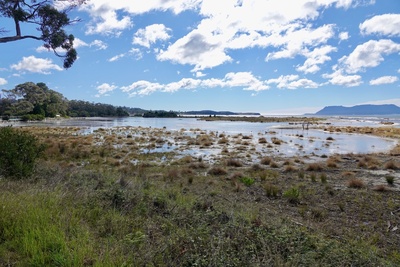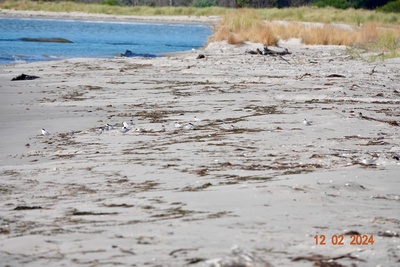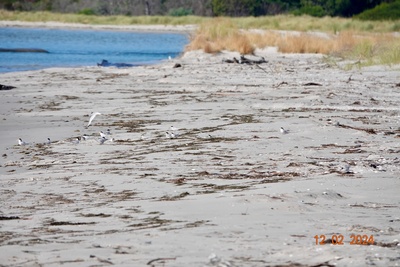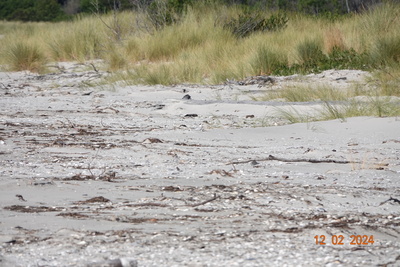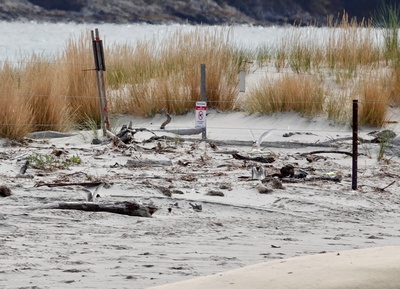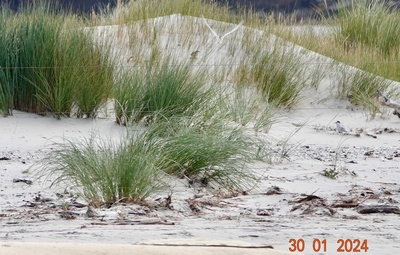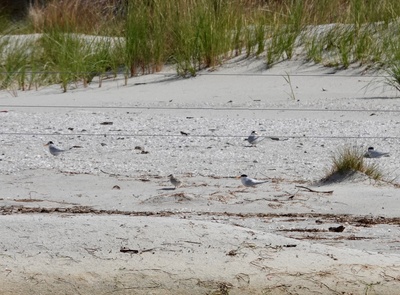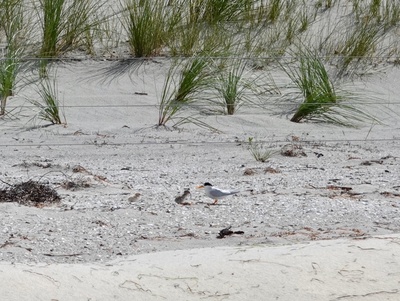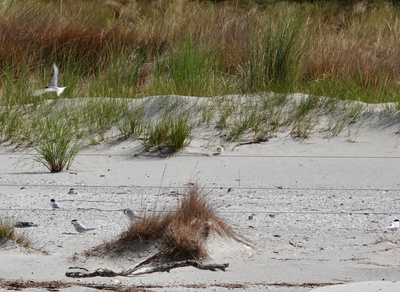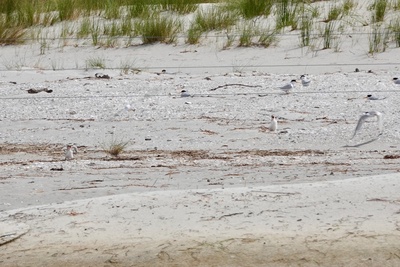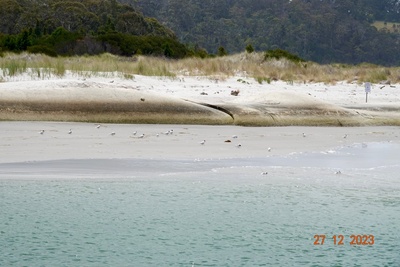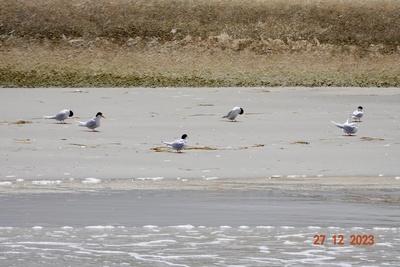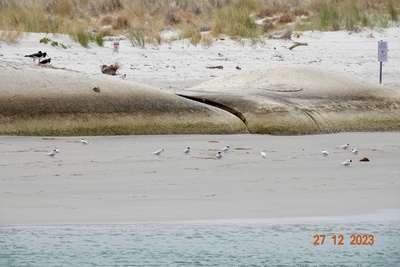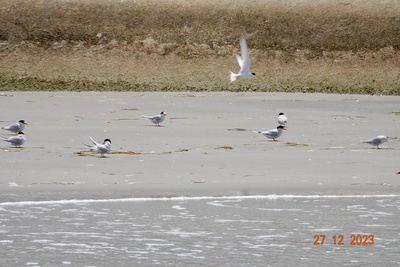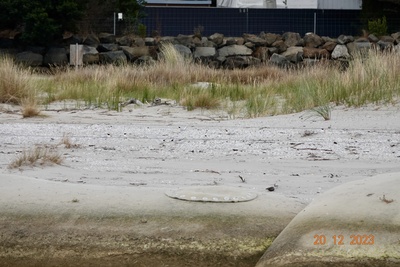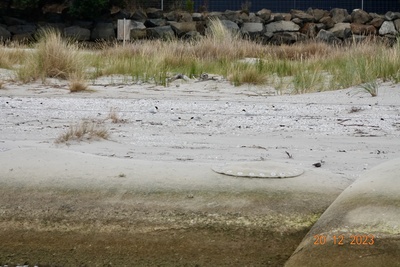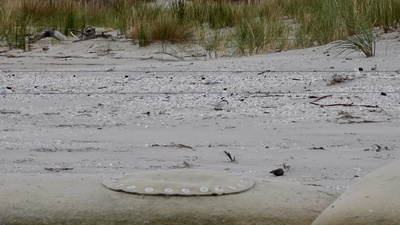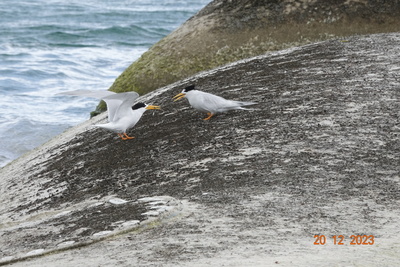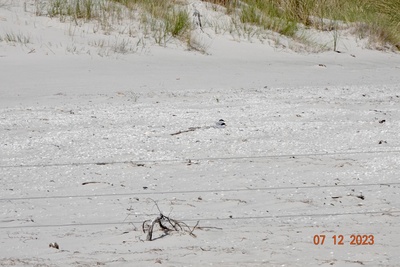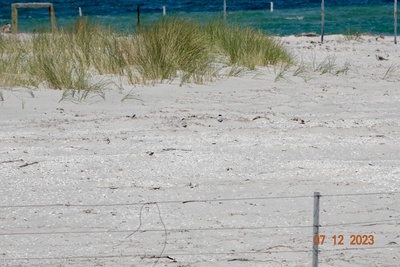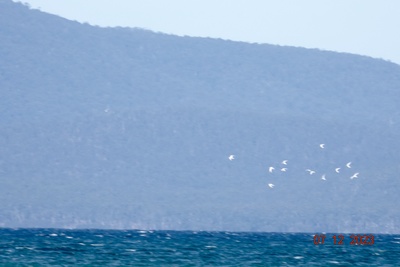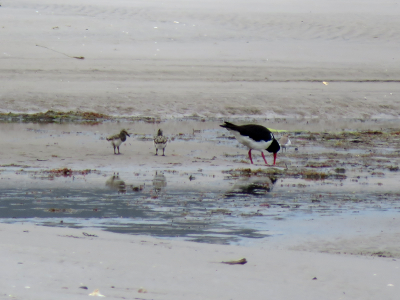Updates from the Orford Bird Sanctuary
Coastal Bird Count
This monitoring had been conducted by Dr Nicky Meeson, Biodiversity Officer from Glamorgan Spring Bay Council. Nicky has now left the council so from 08/02/2022 onwards the coastal bird count is being done by one or more volunteers from the Friends of Orford Bird Sanctuary.
Note: This monitoring is only a count of the birds which are visible from the perimeter of the sanctuary, it isn't a comprehensive count of all the birds that maybe in the sanctuary at that time.
| Latest count | Date: 20/03/2025 | Time: 12:15 - 1:15pm | Tide: 2/3 | Weather: Cloudy and still | ||||||||||||
| Australian Pied Oystercatcher | Hooded Plover | Red-capped Plover | Chestnut Teal | Crested Tern | Kelp Gull | Little-pied cormorant | Masked Lapwing | Pacific Gull | Red-necked Stint | Silver Gull | Sooty Oystercatcher | White-faced Heron |
| 7 | 10 | 15 | 24 | 6 | 1 | 1 | 23 | 1 | 10 | 4 | 10 | 1 |
For previous counts see:
Coastal bird counts from 25/07/2019 to present in table format
or
Orford Bird Sanctuary on Birdlife Australia, Birdata Portal
14 November 2025
Photos by Gary Whisson
29/01/2025 Update by Gary Whisson
I have checked in on the OBS Fairy Tern colony a couple of times this week, late afternoon on Tues 28 Jan from about 6pm for about 40 minutes, and yesterday (Wed 29) from about 4-5pm, both times from the northern end of Millington’s Beach.
The good news is that the tern colony has come through the long weekend ok. I counted some 44 adult Fairy Terns at one time on Tuesday (See Image 1), plus there were other individual terns flying around fishing.
The behaviour of the adult terns Tuesday afternoon appeared to be more flighty than I had observed previously, whether this related to the later time of day, two days of strong winds, or possible disturbance over the long weekend I’m not sure. On several occasions what appeared to be all the adult birds (certainly all the adult birds that I could observe) sitting in the area of the colony took flight almost simultaneously, without any obvious reason for disturbance. They looped around within a couple of hundred metres of the colony site in one or two flocks for several minutes before (mostly) settling back in the area of the colony. Then all took off and repeated this behaviour some minutes later.
I was concerned that this behaviour may have indicated some degree of disturbance over the long weekend, so revisited the site yesterday (Wed 29), a little earlier in the afternoon, from about 4.15 to 5.15pm. The Terns had returned to their previous more settled behaviour, with no mass flights. Individual terns were regularly flying in and out of the colony site, and they appeared to be enjoying good fishing success, including from the Prosser River Channel right in front of me.
Importantly, I observed 5 chicks mostly in the 3-5 day age range (see three in Image 2), but one appeared to be in the older range (see Image 3), likely more than 10 days. There may have been more that were not visible from my vantage point/s.
The Colony occupies a fairly small area on the end of the sand spit, and is relatively densely packed. See Image 4, which includes over 20 adult terns. When the terns settle down in a scrape, the camouflage afforded by the shell and debris covered surface is pretty good - also my camera resolution is struggling at this distance.
Photos below taken from looking across the river channel towards the Sanctuary.
(Click on Images 1 and 3 for higher resolution)
Image 1. The colony in flight. Note the flock is somewhat strung out and flying towards the camera - hence the apparent variation in size of the birds. I estimate about adult 44 Fairy Terns.
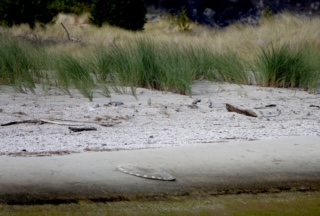
Image 2. There are three chicks in this cropped image (all close to the limit of resolution unfortunately).
From left to right:
- one in front to the slim dark log extending in from the left edge of the image, close to where it connects to a bleached silver piece of timber;
- the second is standing tall wings extended responding to a parent bird flying in, behind and near the end of the piece of timber that extends from the edge of the image;
- the third is more difficult to see. It is a short distance to the right of the chunky brown log in the righthand third of the image, but in this image appears as a small brown fuzzy blob (confirmed as a chick in other images see Image 4).
Image 3. An older chick preening itself behind a clump of grass.

Image 4. There are more than 20 Adult Terns, and one chick (a slightly better image of chick 3 from image 1) visible in this part of the colony, if you can zoom in…. Terns nestled down in sand scrapes can be well camouflaged.
Photos by Gary Whisson
19/01/2025 Update by Gary Whisson
I visited the OBS earlier today to see how the Fairy Tern colony was progressing.
Good news, I counted at least 32 adult terns sitting on the sand, most nestled down into the sand, likely in a nest scrape, with other Terns flying in and out. I say at least 32, because there was a section of the colony behind sandbags and sedges that I couldn’t see, but there were terns flying in and out from this area, so clearly additional birds.
I observed protective behaviours that suggest nesting; Terns chasing a couple of silver gulls away from the colony, and even warning off a pied oystercatcher that was getting too close to a nest. I also observed territorial behaviour towards other Fairy Terns attempting to land too close to a nesting tern.
I counted 6 chicks in the 2-5 day age range, and parent birds flying in with fish to feed them.
Photos below taken from looking across the river channel towards the Sanctuary.
(Click on images for higher resolution)
"Part of the colony area, 12 (?13) Terns in the image, most sitting down in what would appear to be nest scrapes."
"A parent bird with 2 young chicks, (towards the left of the image), note the colour difference between the chicks. A third chick wanders away from another nest (towards the right of the image). It had been sitting in a scrape under one of the small grass tussocks to the left of its position in this image."
Photos by Gary Whisson
28/12/2024 Update
Our beautiful Fairy Terns are once again enjoying summer at Orford Bird Sanctuary (OBS)
Karen Dick, Convenor of Bird Life Tasmania, has been in Orford this morning and reported that there are 29 Fairy Terns in and around the sanctuary. Karen reported that there were at least 6 nests, possibly more and that there was evidence of further mating occurring.
While establishing a colony and during the mating and breeding stages Fairy Terns can be very fickle and it takes very little disturbance for adults to abandon the colony sometimes abandoning dependent chicks which then have no hope of survival.
For the best place to view the Terns (flying and also on the sandspit) go to the end of Millingtons (Orford) Beach, enter the beach from Our Park or walk through the pines at the end of the Esplanade then walk to the mouth of the Prosser River. Enthusiastic bird photographers can also get some good action shots from this area. At this point you are far enough away from the terns not to disturb them but close enough to see these majestic little creatures in flight.
The Orford Bird Sanctuary is one of the few places where Fairy Terns breed in Tasmania. Last year the OBS supported the only colony of Fairy Terns to successfully bred on mainland Tasmania.
Shorebirds including the super cute Hooded Plover can also been seen from the car park at the bird sanctuary just off the Tasman Highway.
PLEASE obey the signs around the sanctuary, by doing this we are all helping to ensure a successful breeding season for all of the shorebirds in the sanctuary.
Fairy Terns are listed under the Federal Environment Protection and Biodiversity Conservation Act 1999 as Vulnerable and Threatened under the Tasmanian Threatened Species Protection Act 1995.
Hooded Plovers are listed under the Federal Environment Protection and Biodiversity Conservation Act 1999 as Vulnerable.
01/12/2024 Update
Below area some images from the Orford Bird Sanctuary taken this morning just after high tide, with a high/strong flow in the Prosser River after last nights rain and large easterly swell (forecast 2-3m).
Again the waves are washing up to the fence and in places beyond the fence along Raspins Beach, and surging over and through the sandbags and fence line along parts of the Prosser River Channel. The fence appeared to be undamaged. Despite these conditions, there were still significant areas of elevated sand along the end of the sand spit that were above the highest extent of wash from this event.
So far this season Fairy Terns have been present in early November (up to 30 birds), absent after a period of strong westerly, and present again a week or so ago (about 20 birds) before being absent again during this weeks persistent damp drizzle and last nights heavy overnight rain and easterly wind event. Today I observed two Fairy Terns briefly flying over and around the end of the sand spit. At the beginning of December, there is still time for the Terns to establish a colony this breeding season.
Aside from the previously mentioned areas at the end of the sand spit that were not impacted by the high water levels and waves over night and this morning, there was very little bare sand habitat available for Hooded Plovers during this mornings high tide, and I did not observe any, though I did not get up close to the end of the Sand Spit.
I observed four pairs of Pied Oystercatchers that are clearly defending breeding territory, three pairs occupying the shores of the lagoon (including one pair with two very active chicks), and one pair at the end of the sand spit and the adjacent southern end of Raspins Beach. There was also at least one pair attempting to establish a breeding territory, but being chased off by the established pairs (total at least 12 birds).
Other birds observed this morning included: approx 50 Chestunt Teal, 3 Black Swans, 1 Pelican, at least 6 Masked Lapwings, several Black-faced Cormorants, two Crested Terns, a White-faced Heron, a Caspian Tern (hunting over the lagoon), Silver Gulls, Pacific Gulls, Welcome Swallows, and a Sea Eagle flying over the lagoon with a fish in its talons (likely heading towards the nest on Louisville Peninsula).
(Click on images for higher resolution)
"Strong river flow, meets easterly swell at high tide - flooding some areas at the end of the sand spit."
"Waves washing up to the base of the foredune / fence along Raspins Beach, The conditions attracted approximately 20 surfers."
"Waves washing up and through the fence along Raspins Beach."
"Contrasting sheltered conditions at high tide in the lagoon."
"An unfortunately not very clear photo of a pair of Pied Oyster-catchers with chicks."
"A Pelican and Chestunt Teals resting on a slightly elevated area of samphire in the lagoon. Samphire is becoming more extensive along the upper (fringing) intertidal shoreline of the lagoon."
Photos by Gary WhissonFairy Tern Breeding 2023-24
This summer Friends of Orford Bird Sanctuary participated in Birdlife Australia’s Fairy Tern census by undertaking three counts of the sanctuary’s Fairy Tern population. These birds are not residents of the sanctuary, or Tasmania, but fly in from mainland Australia to breed here.
(It is common for people to confuse Fairy Terns with other more common and resident tern species like Crested Terns. Crested Terns are much larger being 43-48c long as compared to Fairy Terns which are only 22-24 cm)
Fairy Terns attempted to establish a colony and breed at two other sites on mainland Tasmania; Marion Bay and Scamander but were not successful.
Orford Bird Sanctuary was the only successful Fairy Tern breeding colony on mainland Tasmania. Well done us!
The statistics from our Fairy Tern counts indicate that this season at least 16 Fairy Terns fledged (survived until they were able to fly). While this is not a high number it is considered that this constitutes a reasonably successful season.
This demonstrates the absolute and indisputable importance of our sanctuary for the breeding of the threatened Fairy Tern.
As we celebrate we remain very aware that the survival of the species continues to be of great concern. While establishing a colony, and during the mating and breeding stages, Fairy Terns can be very fickle and it takes little disturbance for adults to abandon the colony sometimes abandoning dependent chicks which then have no hope of survival.
It was, however, very exciting to view the chicks and adults, and hopefully next year, if conditions are right, Fairy Terns will breed and raise their chicks here again.
(Fairy Terns are listed under the Federal Environment Protection and Biodiversity Conservation Act 1999 as Vulnerable and Threatened under the Tasmanian Threatened Species Protection Act 1995)
(Viewing, photographing and monitoring is undertaken at a distance which does not disturb birds)
12th February 2024 - Fairy Tern Count
Todays bird count by three members of Friends of Orford Bird Sanctuary counted 22 Fairy Terns, 8 of which are fledglings.
Below are some Fairy Tern photos from todays bird count.
(Click on images for higher resolution)
30th January 2024 - Fairy Tern Census for Birdlife Australia - Final Count
Friends of Orford Bird Sanctuary participated in the final count for the Fairy Tern Census and below is their description.
"There has been a significant change in the colony since our last count a few weeks ago:
Firstly, the location of the colony has shifted to be much closer to the Raspins Beach side of the Spit. The original site (more or less centrally located at the southern end of the spit), which formed the primary nesting area, and was a hive of activity a few weeks ago, is now deserted.
This may have had something to do with the very high tides recently which inundated the fringes of the nesting colony (but they survived high tides earlier in the breeding season), or perhaps reflects a shift from prioritising nesting sites in the open, to an area with more vegetation and surface cover that chicks can hide in - just my speculation. Hopefully it is not disturbance related.
Our estimated number of adult birds (from counting the birds observed at more or less one time - so likely an underestimate) has dropped from over 50 individuals to closer to 40. We also observed 14 chicks, ranging from about a week old, to chicks that are close to fledging and occupied practicing their flying skills :-). Some adults looked like they could still be sitting on nests.
The drop in the number of adult birds may reflect the natural progression of birds whose chicks have already fledged and so the breeding season is over for them. Again, hopefully it doesn’t reflect the loss of nests, or disturbance."
(Click on images for higher resolution)
"A parent bird flying with a fish, attracting the attention of three chicks in the photograph. The third one is just to the right of the log in the foreground. These chicks look to be at least 3 weeks old, with well developed flight feathers. The fence just behind the ‘nesting’ site is at the southern end of the Raspins Beach Fence. So the location is very susceptible to people walking along the beach to the corner of the fence and along the sandbags in the foreground."
"An adult flying in past a young chick (just below and to the left) on the dune, with a parent bird at the base of the dune to the right. Contrast this terrain with the open bare shell covered sand occupied by the original nesting colony."
"An adult Tern (centre right) that appears to still be sitting on a nest hollowed out of the sand, tucked in next to a clump of seaweed - likely scattered by FOBS volunteers on this area of sand dredged from the channel after last years breeding season. This bird was photographed multiple times and didn’t move during the hour and a half that we were observing the site. A chick, likely just over 2 weeks old is sheltering next to the big log on the left side of the image."
"A parent bird sitting between two logs (centre), with a young (perhaps 2 week old) chick (centre right foreground) is not phased by a Hooded Plover wandering by (to the right). Raspins Beach Fence in the background.
Photos by Gary Whisson18th January 2024 - Fairy Tern Colony Update
Two members from Friends of Orford Bird Sanctuary did a count at Fairy Tern Colony today.
Below is their description of the count:
"The adult bird count was at least 26 birds, but there are increasing numbers of chicks and a lot of birds flying in and out foraging so this does not represent a full census of the number of adult birds. Most likely it has stabilised at around the 50 plus birds.
We didn’t realise it at the time but looking at the photos, in higher definition on the computer screen, I recon we also have an image of an endangered Little Tern sitting in the colony….. See the bird on the left in the image below with the narrow black eyeline extending beyond the eye to the beak.
The Chick in the centre of this image shows how fast some of the chicks are growing, and they have obviously been present earlier that we realised. Small chicks are very hard to spot if they are just crouching in the nest, or under the parent bird -there are a lot of birds sitting in what appears to be nests still. We estimated that we saw at least 10-12 chicks, likely a significant underestimate of actual numbers."
(Click on images for higher resolution)
"Clutch of 2 in this image."
"Three in this image - 2 to the right of the dead Marram grass tussock in the foreground and one at the edge of the Marram grass on the dune at the back. Slightly larger chicks are already wandering some distance from the nest, and hiding in the Marram Grass."
"A pair of larger chicks calling out as a parent bird flies in."
Photos by Gary Whisson27th December 2023 - At least 48 Fairy Terns now at the Orford Bird Sanctuary
Photos by Gary Whisson20th December 2023 - Fairy Terns at the Orford Bird Sanctuary
Photos by Gary Whisson7th December 2023 - Fairy Tern Census
At the request of Birdlife Australia's Beach Nesting Birds Project, Friends of Orford Bird Sanctuary participated in a Fairy Tern Census at the Orford Bird Sanctuary. The census locations extend across Australia's eastern range of the Fairy Tern.
The survey at the Orford Bird Sanctuary on 07/12/2023 identified 20, or more, adult birds displaying colony establishing behaviour.
As part of the census a follow up survey is scheduled for 1-2nd February 2024.
August 2023 - Improvement to breeding area
Collaboration between Marine and Safety Tasmania (MAST), Friends of Orford Bird Sanctuary and the Parks and Wildlife Service (PWS) has resulted in excess sand build-up dredged from the Prosser River mouth being distributed onto the end of the Raspins Beach sandspit (which forms part of the bird sanctuary) to help prevent this potential breeding area from being washed out by storm surges. This area is where the Fairy Terns had one of their most successful bredding seasons in 2020. Since that time the sand had progressively resettled resulting in a significant reduction in suitable breeding habitat.
The Friends of Orford Bird Sanctuary would like to thank MAST and their Contractors for the excellent work that they did in spreading the sand pumped from the Prosser River Channel onto the southern end of the Sandpit at the Orford Bird Sanctuary, raising this area above the intertidal zone and extending the area of potential shorebird nesting habitat.
With the endorsement of PWS and the GSB Council, the Friends of Orford Bird Sanctuary spread seaweed and some driftwood onto the more elevated areas of bare sand resulting from the pumping. These actions were designed to improve habitat texture, diversity and cover for feeding/nesting shorebirds. We were delighted to see the results attract Hooded and Red-necked Plovers before we had even finished spreading the seaweed.
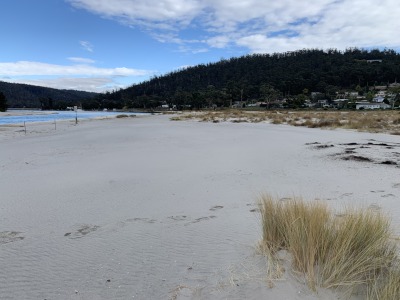 Before - The smooth bare sand on the raised area where the pumped sand was deposited and spread - with our initial efforts in spreading seaweed visible to the right of the image.
Before - The smooth bare sand on the raised area where the pumped sand was deposited and spread - with our initial efforts in spreading seaweed visible to the right of the image.
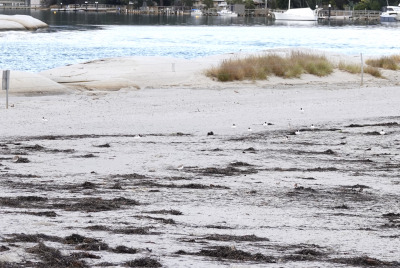 After - Part of the raised area with seaweed increasing the surface texture and diversity. Before we had even finished spreading the seaweed a flock of 12 Hooded Plovers flew in landed on the sandbags and came across to explore and feed amongst the seaweed (11 in the image), along with two Red-capped Plovers.
After - Part of the raised area with seaweed increasing the surface texture and diversity. Before we had even finished spreading the seaweed a flock of 12 Hooded Plovers flew in landed on the sandbags and came across to explore and feed amongst the seaweed (11 in the image), along with two Red-capped Plovers.
July 2023 - Final Orford Foreshore Master Plan endorsed by PWS
The Parks and Wildlife Service have now fully endorsed the Orford Foreshore Masterplan and made it publicly available. This means that action items identified in the plan can now be implemented as resources permit.
View the final, fully endorsed Orford Foreshore Master Plan
March 2023
Orford Bird Sanctuary article in Birdlife Tasmania Autumn 2023 Newsletter
October 2022 - Orford Foreshore Master Plan endorsed by GSBC
At the last meeting of the previous Glamorgan Spring Bay Council, on the 25/10/2022, the council voted to endorse the Orford Foreshore Masterplan as follows.
That Council:
1. Endorse the Orford Foreshore Masterplan in the form of Attachment 1.
2. Does not agree to enter into a lease/licence for the Prosser River Training Wall (sandbags), nor accept responsibility for any maintenance or management of this infrastructure.
3. Review the outcomes and time-frames on a regular basis with the aim to have the implementation of the management plan finalised within 5 years.
View the Council Approved Orford Foreshore Master Plan
June 2022 - Draft Orford Foreshore Master Plan
View the Draft Orford Foreshore Master Plan which has been commissioned by the Glamorgan Spring Bay Council and the Parks and Wildlife Service. The plan assesses and makes recommendations for the future management of the foreshore reserves from Raspins Beach to Millingtons Beach, including the Oford Bird Sanctuary.
View the Friends of Orford Bird Sanctuary's response to the Draft Orford Foreshore Master Plan
October 2021 - Master Plan for the Management of the Prosser River Foreshore Reserve and Orford Bird Sanctuary
Consultants, Inspiring Place https://www.inspiringplace.com.au/, in conjunction with North Barker https://www.northbarker.com.au/, have been engaged by Glamorgan Spring Bay Council and the Parks and Wildlife Service to prepare a Master Plan for the management of the Prosser River foreshore reserve and the Orford Bird Sanctuary. Recently they visited the Sanctuary with Dr Eric Woehler, Convenor of Birdlife Tasmania, to gain expert insight into the complexities of this Important Bird Area!
October 2021
Spring time here has seen the appearance of a Red Necked Stint, two Caspian Terns, and a start to breeding by Hooded Plovers, Red Capped Plovers and Pied Oyster Catchers! Two pairs of Fairy Terns have also been spotted.
Spring 2020
October has seen the start of the breeding season for the Red Cap Plovers, Hooded Plovers and Pied Oyster Catchers here at the Orford Bird Sanctuar.
One of the council's NRM officers has been putting up temporary fences around each nest / nest area in an attempt to keep the nests safe from wandering humans. Additional temporary signs have also been in place since the start of spring.
Two to three Fairy Terns have been seen flying around on a number of occasions.
The first chicks to be seen in the open were two to three Red Cap Plovers in October, followed by a few Hoodies in early November. Some Piedys have been nesting here since October but the fisrt chicks to be seen in the open appeared on the 28/11/2020.
5th August 2020
Review of the Community Consultation and Recommendations regarding the Proposed Management Plan for the Orford Bird SanctuaryIf above link doesn't work, use this one.
February 2020
Report, including stunning photography, by Elaine McDonald and Penny Geard on the Fairy Tern breeding colony at the Orford Bird Sanctuary during January and February 2020. Orford Fairy Tern Colony - Breeding season 2020.pdf
Update From Dr Eric Woehler - 13/02/2020
I visited the colony yesterday afternoon to survey the breeding Fairy Terns. I am delighted to report that 34 chicks and fledged juveniles were observed. This total comprised approximately 20 chicks that were too young to fly, and at least 14 flying juveniles that had successfully fledged but were still in attendance at the colony. The colony was very busy and very noisy, with foraging adults feeding chicks predominantly inside the eastern extent of the fenced area and on the adjacent foreshore. Foraging trips by the adults were from both the backwater and from the bay east of the colony.
On two occasions, boats with fishers on board entered the channel - all roosting Fairy Terns and Crested Terns immediately flew off the bags - any claims that the terns 'tolerate' these events are baseless and easily refuted.
An estimated 26 adults were in view, in the colony and feeding chicks. Thus, on 13 Feb 2020, a total of 60 Fairy Terns were observed (26 adults and 34 chicks and juveniles). This is the most successful this colony has been for more than a decade.
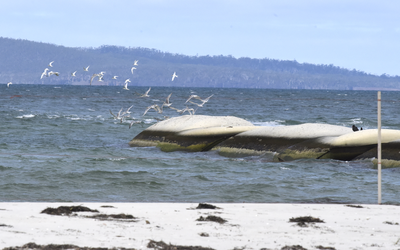 Photo © Eric J Woehler
Photo © Eric J WoehlerFairy and Crested Terns flying off the bags in response to a boat with fishers entering the channel. The boat's wake can be seen in the water.
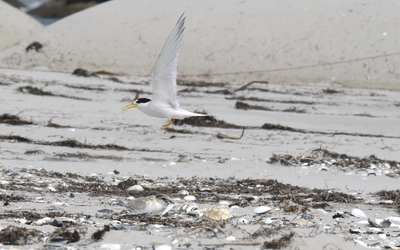 Photo © Eric J Woehler
Photo © Eric J WoehlerAdult fairy tern departing after feeding its chick a large fish - the chick is immediately under the flying adult with the fish in its bill.
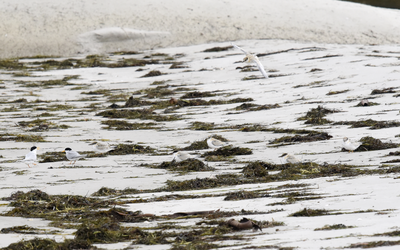 Photo © Eric J Woehler
Photo © Eric J WoehlerTwo adults and six chicks/juveniles on foreshore. One fledged juvenile can be seen flying.
I would encourage Council to maintain the fence and protective measures around this critical shorebird and small tern site that is internationally recognised for its contribution to the conservation of global biodiversity as an Important Bird Area.
Obfuscation by residents raising "concerns" about high tides are designed to introduce doubt in Councillor's minds. The colony's success undermines the various claims by fence opponents.
I remain open to discussions with Councillors who wish to protect the site.
Eric
January 2020
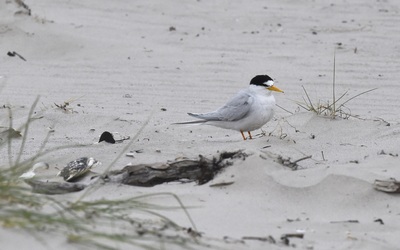 Little Tern © Eric J Woehler
Little Tern © Eric J Woehler
Update From Dr Eric Woehler - 21/01/2020
A CRITICAL update to the Fairy Tern colony status at the Orford Bird Sanctuary following my second visit to the site today.
I visited the colony this morning (21 Jan 20 08:13 - 09:15 AEDST) and there were at least 25 adult birds sitting on nests - either incubating eggs or brooding very small chicks. At least another 20 birds were observed returning to the colony to feed partners and chicks.
Many adults were observed feeding in the backwater - more so than in the bay east of the Spit. Clearly, the backwater remains a critical feeding site for the nesting terns.
At least 6 chicks of various sizes were observed running around the colony being fed by adults during our visit.
I believe that there are still close to 30 active nests present in the Sanctuary - comprising incubating and brooding nests with sitting adults, and nests whose chicks have started to roam in the vicinity of the nest/territory.
Remarkably, at least one Little Tern (Critically Endangered) was observed in the colony - its behaviour strongly suggested breeding but I could not see its partner or its nest. If breeding, this is only the 3rd known breeding pair for this species in Tasmania this season (the other pairs are on King Island and Cape Barren Island).
The presence of the Little Tern increases the conservation significance of the colony dramatically. This is the only known instance of Little Terns breeding on the Tasmanian mainland this season - a remarkable observation. I have attached a picture of the Little Tern.
I strongly urge Council to reject any proposal for removing the fence around this colony. The colony's conservation status is increasing and is of national and international significance. The selfish wishes of a handful of locals is no basis for the loss of this site of International conservation significance.


